Name Gerald R. Ford Awarded 10 September 2008 Sponsored by Susan Ford Launched 9 November 2013 Builder Newport News Shipbuilding | Namesake Gerald R. Ford Laid down 13 November 2009 Construction started 13 November 2009 Length 337 m | |
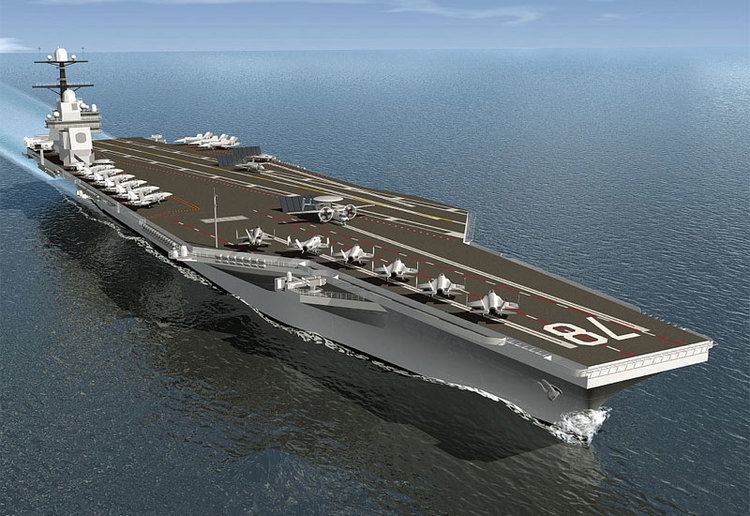 | ||
Cost $12.8 billion + $4.7 billion R&D (estimated) | ||
Gerald R. Ford (CVN-78) is the lead ship of her class of United States Navy supercarriers. It is currently a pre-commissioning unit (PCU) expected to be commissioned into the Navy in 2017. The ship is named after the 38th President of the United States Gerald R. Ford, whose World War II naval service included combat duty aboard the light aircraft carrier Monterey in the Pacific Theater.
Contents
- Uss gerald r ford supercarrier tests amazing new electromagnetic catapult launch system
- Naming
- Construction
- Performance improvements
- Operational testing
- References

The keel of Gerald R. Ford was laid down on 13 November 2009. Construction began on 11 August 2005, when Northrop Grumman held a ceremonial steel cut for a 15-ton plate that forms part of a side shell unit of the carrier. She was christened on 9 November 2013. The schedule called for the ship to join the U.S. Navy's fleet in March 2016 with the first deployment in 2019. Gerald R. Ford will enter the fleet replacing the inactive USS Enterprise (CVN-65), which ended her 51 years of active service in December 2012.
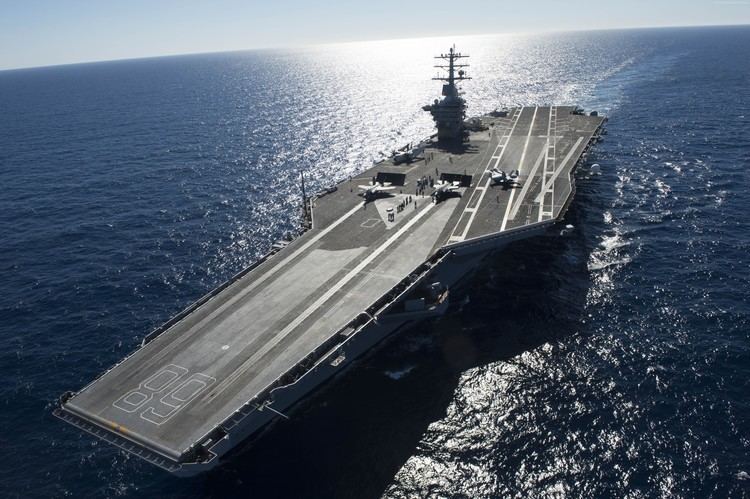
Uss gerald r ford supercarrier tests amazing new electromagnetic catapult launch system
Naming
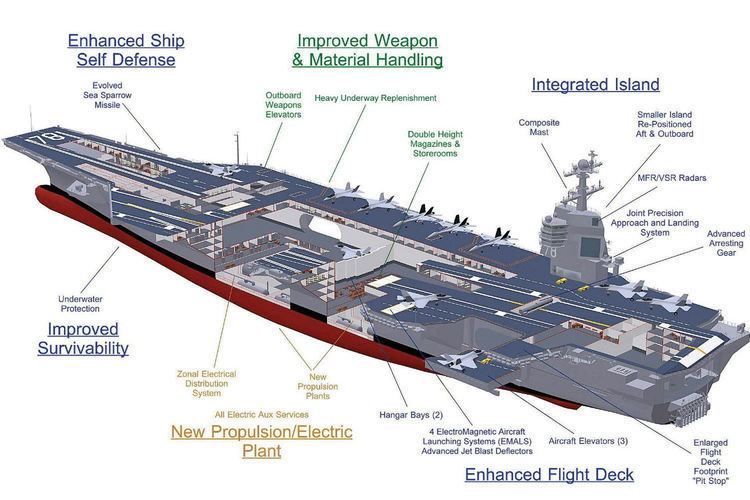
In 2006, while Gerald Ford was still alive, Senator John Warner of Virginia proposed to amend a 2007 defense-spending bill to declare that CVN-78 "shall be named the USS Gerald Ford." The final version signed by President George W. Bush on 17 October 2006 declared only that it "is the sense of Congress that ... CVN-78 should be named the U.S.S. Gerald R. Ford." Since such "sense of" language is typically non-binding and does not carry the force of law, the Navy was not required to name the ship after Ford.
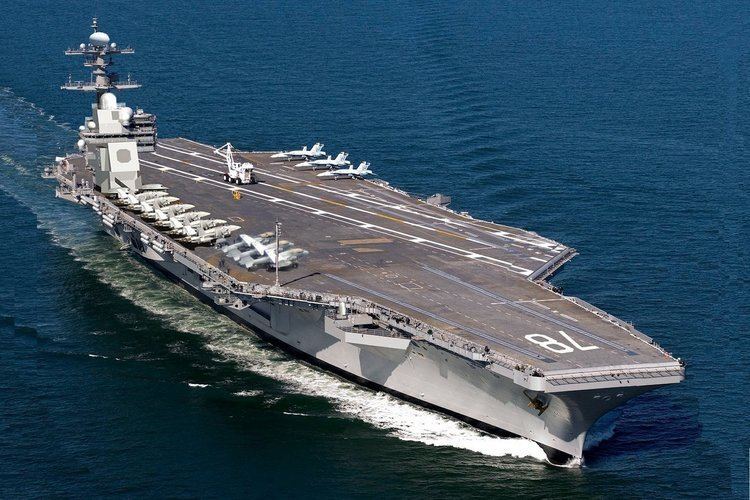
On 3 January 2007, former United States Secretary of Defense Donald Rumsfeld announced that the aircraft carrier would be named after Ford during a eulogy for President Ford at Grace Episcopal Church in East Grand Rapids, Michigan. Rumsfeld indicated that he had personally told Ford of the honor during a visit to his home in Rancho Mirage a few weeks before Ford's death. This makes the aircraft carrier one of the few U.S. ships named after a living person. Later in the day, the Navy confirmed that the aircraft carrier would indeed be named after the former President. On 16 January 2007, Navy Secretary Donald Winter officially named CVN-78 USS Gerald R. Ford. Ford's daughter Susan Ford Bales was named the ship's sponsor. The announcements were made at a Pentagon ceremony attended by Vice President Dick Cheney, Senators Warner (R-VA) and Levin (D-MI), Major General Guy C. Swan III, Bales, Ford's other three children, and others.
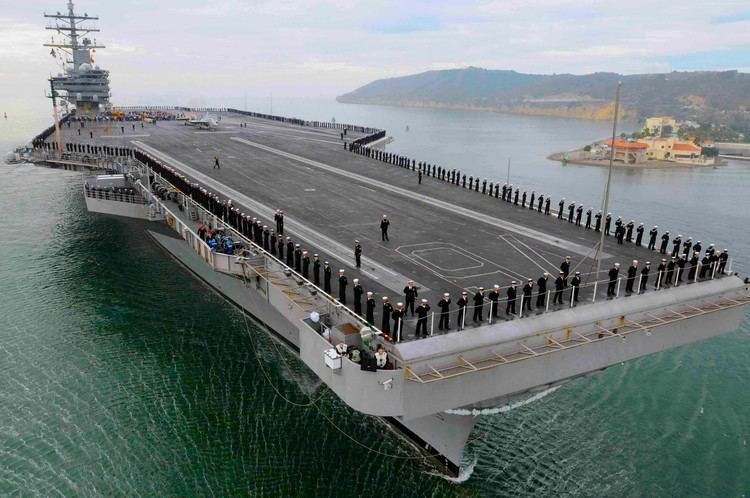
The USS America Carrier Veterans Association (CVA) had pushed to name the ship USS America. The CVA is an association of sailors who served aboard USS America (CV-66). The carrier was decommissioned in 1996 and scuttled in the Atlantic, as part of a damage test of large deck aircraft carriers in 2005, and LHA-6 was named America.
Construction
On 10 September 2008, the U.S. Navy signed a $5.1 billion contract with Northrop Grumman Shipbuilding in Newport News, Virginia, to design and construct the carrier. Northrop had begun advance construction of the carrier under a $2.7 billion contract in 2005. The carrier is being constructed at the Huntington Ingalls (formerly Northrop Grumman) Newport News Shipbuilding facilities in Newport News, Virginia, which employs 19,000 workers.
The keel of the new warship was ceremonially laid on 14 November 2009 in Dry Dock 12 by Ford's daughter, Susan Ford Bales. In a speech to the assembled shipworkers and DoD officials, Bales said: "Dad met the staggering challenges of restoring trust in the presidency and healing the nation's wounds after Watergate in the only way he knew how — with complete honesty and integrity. And that is the legacy we remember this morning."
As of August 2011, the carrier was reported to be "structurally halfway complete". In April 2012, it was said to be 75 percent complete. On 24 May 2012, the important milestone of completing the vessel up to the waterline was reached when the critical lower bow was lifted into place. This was the 390th of the nearly 500 lifts of the integral modular components (from which the vessel is assembled) that the ship's construction will ultimately require. On 8 October 2012, the carrier reached over 88 percent of the complete structural construction. Huntington Ingalls reported (in an 8 Nov. 2012 press release) that they have "Reached 87 percent structural completion of CVN-78 Gerald R. Ford". By 19 December 2012, construction had reached 90 percent structural completion. "Of the nearly 500 total structural lifts needed to complete the ship, 446 have been accomplished."
The island was originally scheduled to land in 2012. However, the island landing and ceremony actually took place on 26 January 2013.
On 9 April 2013, the flight deck of the carrier was completed following the addition of the ship's upper bow section, bringing the ship to 96 percent structural completion.
On 7 May 2013, the last of 162 superlifts was put in place, bringing the ship to 100 percent structural completion. Remaining work that needed to be done included hull painting, shafting work, completion of electrical systems, mooring equipment, installation of radar arrays, and flooding of the dry dock.
On 11 July 2013, a time capsule was welded into a small room just above the floor, continuing a long Navy tradition. The time capsule holds items chosen by President Ford's daughter, Susan Ford Bales, and includes sandstone from the White House, Navy coins, and aviator wings from its first commanding officer.
The ship was originally scheduled for launch in July 2013 and delivery in 2015. Production delays meant that the launch had to be delayed until 11 October 2013 and the naming ceremony until 9 November 2013, with delivery February 2016.
On 3 October 2013, Gerald R. Ford had four 30-ton, 21 ft (6.4 m)-diameter bronze propellers installed. The installation of the propellers required more than 10 months of work to install the underwater shafting.
On 11 October 2013, the ship's drydock was flooded for the first time in order to test various seawater-based systems. Her launch date was set to be on the same day as her naming ceremony on 9 November 2013.
On 9 November 2013, the ship was christened by Ford's daughter, Susan Ford Bales, with a bottle of American sparkling wine.
As of 2013, construction costs were estimated at $12.8 billion, 22% over the 2008 budget, plus $4.7 billion in research and development costs. Because of budget difficulties, the Chief of Naval Operations, Admiral Jonathan Greenert, has warned there may be a two-year delay beyond 2016 in completing Gerald R. Ford. The GAO reports that the price cap will be met by the Navy accepting an incomplete ship for that cost.
On 23 September 2015, the Navy announced that several weeks of testing delays will likely slip the delivery date into April or May 2016. In addition, construction was 93% complete as of September 2015.
In July 2016, a memo was obtained by CNN from Michael Gilmore, the US Department of Defense's Director of Operational Testing and Evaluation indicating that problems with four major flight systems would further delay combat readiness of the ship. The ship was not expected to be delivered until November 2016 and these issues were suggested to further delay that goal. Construction of the ship is described as 98% complete, with 88% of testing finished.
Performance improvements
Gerald R. Ford is intended to be the first of a class of aircraft carriers that offer significant performance improvements over the previous Nimitz class. Gerald R. Ford is equipped with an AN/SPY-3 active electronically scanned array multi-function radar, and an island that is shorter in length and 20 feet (6.1 m) taller than that of the Nimitz class; it is set 140 feet (43 m) further aft and 3 feet (0.91 m) closer to the edge of the ship. Replacing traditional steam catapults, the Electromagnetic Aircraft Launch System (EMALS) will launch all carrier aircraft. This innovation eliminates the traditional requirement to generate and store steam, freeing up considerable below-deck square footage. With this EMALS innovation, Gerald R. Ford can accomplish 25% more aircraft launches per day than the Nimitz class and requires 25% fewer crew members. The Navy estimates it will save $4 billion in operating costs over a 50-year lifespan. According to an Associated Press story:
‘She is truly a technological marvel,' Chief of Naval Operations Adm. Jonathan Greenert said in a webcast ceremony at the Newport News, Va., shipyard where Gerald R. Ford is being built. 'She will carry unmanned aircraft, joint strike fighters, and she will deploy lasers.’
However, these performance enhancers have proven problematic in Pentagon tests.
Operational testing
In January 2014, the annual Director, Operational Test and Evaluation (DOT&E) report said that critical ship systems including the EMALS, Advanced Arresting Gear (AAG), Dual Band Radar, and weapons elevators were not reliable enough and needed more testing and improvements. EMALS testing recorded 201 launch failures out of 1,967 launches, equaling a reliability rate of 240 mean cycles (launching of one aircraft) between critical failures. Testing of the AAG recorded 9 arresting failures out of 71 attempts, equaling a reliability rate of 20 mean cycles (recovery of one aircraft) between operational mission failure, a failure rate 248 times higher than should be expected. Those systems performed at a fraction of their requirements for shipboard configurations, and even less of required standards. Radar and weapons elevator test data was not made available, but were also below expectations. The Navy maintains that further testing will resolve the problems. Tests also showed that the launching and landing systems on Gerald R. Ford would place extra stress on aircraft with external fuel tanks. Gerald R. Ford is projected to be able to generate 30 percent more sorties than Nimitz-class carriers, but the DOT&E report claims that is too optimistic, though the Navy also maintains that assumption based on modeling and simulations. Major problems with the Main Turbine Generators were found in summer 2016. Gerald R. Ford is planned to complete Initial Operational Test & Evaluation in 2017 before entering service.
